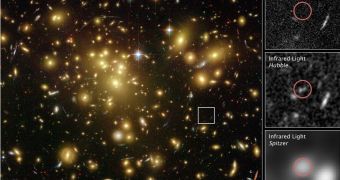Using the help provided by a gravitational lensing phenomenon created by a large galaxy cluster, known as Abell 1689, astronomers from NASA have discovered, with the Hubble and Spitzer space telescopes, what seems to be one of the youngest and brightest galaxies in the universe, located more than 12.8 billion light years away from Earth. They argue it might be one of the first galaxies to populate the universe, only 700 million years after the Big Bang event.
It is so far away that, in fact, the optical camera of the Hubble space telescope cannot actually detect it. However, the Near Infrared Camera and the Multi-Object Spectrometer are able to reveal the galaxy, dubbed A1689-zD1. Images from Spitzer's Infrared Array Camera suggest that, 12.8 billion years away ago, the young galaxy was going through an extremely intense star formation process, which eventually re-heated the cold hydrogen gas, remnant of the so-called dark ages of the universe, the period after the Big Bang when no stars existed.
The redshift of the light emitted by the distant galaxy is so severe that the optical light emitted by it is shifted into the infrared light spectrum, as NASA says, an ideal candidate for study with the James Webb Space Telescope.
Cosmological theories regarding our universe argue that, about 400,000 years after the Big Bang, matter cooled in cold hydrogen clouds that expanded throughout the whole universe like a thick fog. As gas cooled, it was allowed to collapse into larger and larger objects, until the first sign of light emitted by the first star invaded that darkness of space, and even more stars and galaxies started forming. It is clear that during those moments, quasars could have not existed in order to provide enough energy to re-heat the matter in the universe, thus the star-forming galaxies might have taken such a role.
The galaxy still evades direct observation, luckily the Abell 1689 galaxy cluster, located about 2.2 billion light years away, provides with enough magnification to enhance the brightness as much as 10 times, revealing bright light emitted by massive stars in a compact region of space spanning about 2,000 light years into space (about 50 times less than the whole width of the Milky Way).
Infrared observations of the galaxy approximate its mass only to about a few billion times larger than that of our Sun. Even with gravitational lensing, the Hubble Space Telescope is unable to observe in visible light some of the most massive stars inside it, nor the material surrounding them. The JWST will probably have more chances than Hubble, as its total mirror area is about seven times larger than that of Hubble's mirror.
Alternatively, the young galaxy could also be studied with the help of the Atacama Large Millimeter Array radio telescope, due to be completed in 2012, to provide accurate measurements of the motion of molecular gas inside it. In anticipation for the future observations, they will study the galaxy through infrared spectroscopy techniques with the help of the Keck Telescope.

 14 DAY TRIAL //
14 DAY TRIAL //